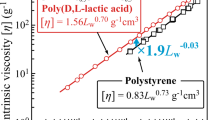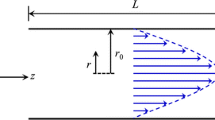Abstract
We present a method by which to obtain the absolute, chemical-heterogeneity-corrected molar mass (M) averages and distributions of copolymers and apply the method to a gradient random copolymer of styrene and methyl methacrylate in which the styrene percentage decreases from approximately 30% to 19% as a function of increasing molar mass. The method consists of separation by size-exclusion chromatography (SEC) with detection using multi-angle static light scattering (MALS), differential viscometry (VISC), differential refractometry (DRI), and ultraviolet absorption spectroscopy (UV) and relies on the preferential absorption of styrene over methyl methacrylate at 260 nm. Using this quadruple-detector SEC/MALS/UV/VISC/DRI approach, the percentage of styrene (%St) in each elution slice is determined. This %St is then used to determine the specific refractive index increment, corrected for chemical composition, at each elution slice, which is then used to obtain the molar mass at each slice, corrected for chemical composition. From this corrected molar mass and from the chemical-composition-corrected refractometer response, the absolute, chemical-heterogeneity-corrected molar mass averages and distribution of the copolymer are calculated. The corrected molar mass and intrinsic viscosity at each SEC elution slice are used to construct a chemical-heterogeneity-corrected Mark–Houwink plot. The slice-wise-corrected M data are used, in conjunction with the MALS-determined R G,z of each slice, to construct a conformation plot corrected for chemical heterogeneity. The corrected molar mass distribution (MMD) of the gradient copolymer extends over an approximately 30,000 g/mol wider range than the uncorrected MMD. Additionally, correction of the Mark–Houwink and conformation plots for the effects of chemical heterogeneity shows that the copolymer adopts a more compact conformation in solution than originally concluded.

Table of Contents Graphic




Similar content being viewed by others
References
O'Leary K, Paul DR (2004) Polymer 45:6575–6585
Stejskal J (2005) Polym Int 54:108–113
Stejskal J, Kratochvil P (1978) Macromolecules 11:1097–1103
Medrano R, Laguna MTR, Saiz E, Tarazona MP (2003) Phys Chem Chem Phys 5:151–157
Nielsen LE (1953) J Am Chem Soc 75:1436–1439
Benkoski JJ, Fredrickson GH, Kramer EJ (2001) J Polym Sci B, Polym Phys 39:2363–2377
Netopilík M, Bohdanecký M, Kratochvíl P (1996) Macromolecules 29:6023–6030
Stoyanov C, Shirazi ZH, Audu TOK (1978) Chromatographia 11:63–69
Mori S, Uno Y (1987) J Appl Polym Sci 34:2689–2699
Pasch H, Trathnigg B (1999) HPLC of polymers. Springer, Berlin
Striegel AM (2005) Anal Chem 77:104A–113A
Mourey TH (2004) Int J Polym Anal Charact 9:97–135
Striegel AM, Yau WW, Kirkland JJ, Bly DD (2009) Modern size-exclusion liquid chromatography, 2nd edn. Wiley, New York
Striegel AM (ed) (2005) Multiple detection in size-exclusion chromatography. ACS Symposium Series, vol 893. American Chemical Society, Washington, DC
Haidar Ahmad IA (2008) Master’s thesis. Florida State University
Michielsen S (1999) In: Brandrup J, Immergut EH (eds) Polymer handbook, 4th edn. Wiley, New York, pp VII/547–VII/627
Ahuja SK (1980) Rheol Acta 19:299–306
Kennedy MA, Peacock AJ, Failla MD, Lucas JC, Mandelkern L (1995) Macromolecules 28:1407–1421
Alamo RG, Mandelkern L (1991) Macromolecules 24:6480–6493
Alamo RG, Viers BD, Mandelkern L (1993) Macromolecules 26:5740–5747
Alamo RG, Chan EKM, Mandelkern L, Voigt-Martin IG (1992) Macromolecules 25:6381–6394
Huser T, Yan M (2001) J Photochem Photobiol 144:43–51
Nguyen T-Q, Doan V, Schwartz BJ (1999) J Chem Phys 110:4068–4078
Schimpf ME (2002) J Liq Chromatogr Relat Technol 25:2101–2134
Lee S, Kwon O-S (1995) In: Provder T, Barth HG, Urban MW (eds) Chromatographic characterization of polymers. Hyphenated and multidimensional techniques. Advances in chemistry series, vol 247. American Chemical Society, Washington, pp 93–107
Gunderson JJ, Giddings JC (1986) Macromolecules 19:2618–2621
Schimpf ME, Giddings JC (1989) J Polym Sci B, Polym Phys 27:1317–1332
Kohjiya S, Iwata K, Yamashita S, Miyamoto T, Inagaki H (1983) Polym J 15:869–874
Kotaka T, White JL (1974) Macromolecules 7:106–116
Inagaki H, Tanaka T (1982) Pure Appl Chem 54:309–322
Kramer I, Pasch H, Handel H, Albert K (1999) Macromol Chem Phys 200:1734–1744
Albert K (1995) J Chromatogr A 703:123–147
Dekmezian AH, Morioka T, Camp CE (1990) J Polym Sci B, Polym Phys 28:1903–1915
Mirabella FM, Barrall EM, Johnson JF (1975) J Appl Polym Sci 19:2131–2141
Hunt BJ, Holding SR (eds) (1989) Size exclusion chromatography. Blackie, Glasgow
Mori S, Suzuki T (1981) J Liq Chromatogr 4:1685–1696
Meselson M, Stahl FW, Vinograd J (1957) Proc Natl Acad Sci USA 43:581–588
Stacy CJ (1977) J Appl Polym Sci 21:2231–2240
Poddubnyi IY, Podalinskii AV, Grechanovskii VA (1972) Vysokomol Soyed 14:714–721
Staggemeier B, Huang QR, Dubin PL, Morishima Y, Sato T (2000) Anal Chem 72:255–258
Montaudo MS (2005) In: Striegel AM (ed) Multiple detection in size-exclusion chromatography. ACS symposium series, vol 893. American Chemical Society, Washington, pp 152–167
Stuting HH, Krull IS (1990) Anal Chem 62:2107–2114
Lee DC, Speckhard TA, Sorensen AD, Cooper SL (1986) Macromolecules 19:2383–2390
Trainoff SP (2005) US Patent 2005/0075851A1
Balke ST, Mourey TH (2001) J Appl Polym Sci 81:370–383
Gillespie D, Yau WW, Gipson T (1999) 1998 Int GPC Symp Proc, Waters, Milford, MA, pp. 32–47
Elias H-G (1996) An introduction to polymers. VCH, Weinheim
Blythe AR (1979) Electrical properties of polymers. Cambridge University Press, Cambridge
Schmack G, Tandler B, Vogel R, Beyreuther R, Jacobsen S, Fritz HG (1999) J Appl Polym Sci 73:2785–2797
Koningsveld R (1972) Chem Zvesti 26:263–287
Krause S (1986) Pure Appl Chem 58:1553–1560
Acknowledgments
Acknowledgment is made to the Donors of the American Chemical Society Petroleum Research Fund for partial support of this research through grant 1-1312-0050. We would also like to thank Dr. Deborah Striegel (Department of Mathematics, Florida State University) for her assistance with the “Appendix”, Mr. Dustin Richard (Department of Chemistry and Biochemistry, Florida State University) for the PS and PMMA calibration curve data, and Professor Michael Roper (Department of Chemistry and Biochemistry, Florida State University) for his kind loan of a UV detector and for helpful advice and discussions.
Author information
Authors and Affiliations
Corresponding author
Appendix
Appendix
Correcting the R G, z of a bulk copolymer for chemical heterogeneity
In an SEC/MALS/DRI experiment, the z-average radius of gyration R G,z of a bulk homopolymer (i.e., not the R G,z of each SEC elution slice, to which we shall refer here for simplicity as r i ) which, by definition, does not necessitate correction for chemical heterogeneity, is calculated according to [13]:
We want to find the corrected R G,z value of a copolymer which possesses chemical heterogeneity, given the corrected concentration c and molar mass M values. We have
where c i is the corrected c value at slice i, M i is the corrected M value at slice i, \( {\delta_{{c_i}}} \) is the amount of correction of c at slice i, and \( {\delta_{{M_i}}} \)is the amount of correction for M at slice i (with the realization that the various δ terms may be either positive or negative).
By expansion
Because \( \sum\limits_i {{c_i}{M_i}} \)is needed in the corrected R G,z equation, let the right-hand side of Eq. 17 be written as
where \( {\varepsilon_i} = {\delta_{{c_i}}}{M_i} + {\delta_{{M_i}}}{c_i} + {\delta_{{c_i}}}{\delta_{{M_i}}} \).
Substituting Eq. 18 into Eq. 16 results in
Manipulation of Eq. 19 results in
Dividing both sides by \( \sum\limits_i {{c_i}{M_i}} \) yields
As per Eq. 15, the right-hand side of Eq. 21 is the corrected value of R G,z , i.e., R G,z,corrected. Simplifying Eq. 21 results in
Rights and permissions
About this article
Cite this article
Haidar Ahmad, I.A., Striegel, A.M. Determining the absolute, chemical-heterogeneity-corrected molar mass averages, distribution, and solution conformation of random copolymers. Anal Bioanal Chem 396, 1589–1598 (2010). https://doi.org/10.1007/s00216-009-3320-9
Received:
Revised:
Accepted:
Published:
Issue Date:
DOI: https://doi.org/10.1007/s00216-009-3320-9




